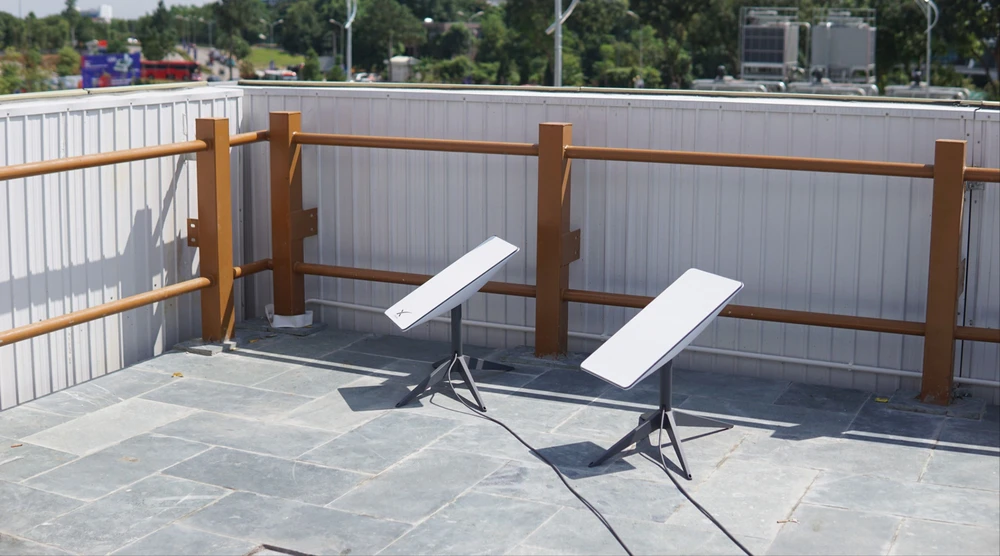Prepare to connect
During a meeting with Deputy Prime Minister Nguyen Chi Dung in early April 2025, Minister of Science and Technology Nguyen Manh Hung outlined two main tasks for the ministry this year: accelerating mobile internet speeds by upgrading and expanding the 5G network and piloting the Starlink satellite internet service.
During the meeting, Mr. Nguyen Thanh Chung, Director of the Telecommunications Department (Ministry of Science and Technology), stated that they are working with SpaceX to support the company in completing the next steps before it can operate in Vietnam. This includes SpaceX establishing a business and installing ground gateway stations in Vietnam. These stations will be used for Starlink satellite internet connectivity throughout Vietnam.
Also in April 2025, the Government granted SpaceX a license to conduct a controlled pilot project to invest in and operate a satellite telecommunications network service using low-orbit satellite technology in Vietnam (Starlink service). This is considered a new turning point for the broadband internet market in Vietnam.

According to the government's decision, SpaceX is granted a conditional pilot service for a period of 5 years, which must end before January 1, 2031; the maximum number of subscribers is 600,000, while also ensuring national defense and security requirements.
The provider must place a gateway station within Vietnam, ensuring that all traffic generated by satellite subscribers within Vietnam passes through the gateway and connects to the domestic public telecommunications network. The service must ensure that the information and data of service users in Vietnam are stored in Vietnam; and comply with requirements for preventing the spread of malware, cyberattacks, and malicious information.
Other developments suggest that SpaceX's gateway station could be operational in Da Nang City as early as the end of May or June. Vietnam may allow billionaire Elon Musk's satellite internet company to install 10-15 stations nationwide.
If the plans proceed as scheduled, in 2025, internet users in Vietnam will soon be able to experience Starlink satellite internet service. This will also create new competitive impetus for network operators to quickly complete their telecommunications infrastructure, bring fiber optic cables to households, and accelerate 5G coverage nationwide.
Support for areas with "off-network coverage"
Starlink is a satellite internet project developed by SpaceX since 2019. The system has over 6,000 low Earth orbit satellites, providing internet connectivity to many areas around the world, especially those with limited traditional network infrastructure. SpaceX began offering Starlink services in the US in October 2020. To date, the service serves nearly 3 million customers in over 100 countries worldwide. The average price for Starlink is $99 per month (approximately 2.4 million VND).
According to experts, the deployment of Starlink services is expected to boost digital transformation and bridge the digital divide in Vietnam. However, to achieve high effectiveness, close cooperation between SpaceX and domestic telecommunications companies is needed, along with investment in infrastructure and supply chains, because Starlink services are the optimal solution for areas with poor signal coverage in remote regions – where 4G, 5G, and fiber optic networks have not yet reached Vietnam.
Initially, Starlink may provide high-speed internet in remote areas, islands, and places where Vietnamese network operators face difficulties in deploying fiber optic and 4G/5G infrastructure. In these areas, customers can choose Starlink instead of traditional solutions like fiber optics, especially when 4G and 5G mobile service coverage is weak.
A representative from a telecommunications company shared: “Starlink cannot completely replace fiber optic cable or mobile networks because it still has higher latency and is dependent on weather conditions. Starlink will create new competitive momentum for telecommunications companies to quickly complete their telecommunications infrastructure, bring fiber optic cable to households, and accelerate 5G coverage nationwide.”
According to statistics from the Telecommunications Department (Ministry of Science and Technology), Vietnam's mobile network currently covers 99.8% of the population; however, it only covers about 58% of the land area and 14.5% of the territory if sea areas are included. In addition, 17% of Vietnamese households still do not use fiber optic services, including many households in remote areas.
To date, all three major Vietnamese mobile networks – Viettel, VNPT, and MobiFone – have officially launched 5G services. Regarding subscribers, in early March, Viettel reported 5.5 million 5G users, while VNPT VinaPhone reached over 3 million. Meanwhile, MobiFone launched 5G at the end of March and reported over 2.5 million users after one month of deployment…
Not dependent on telecommunications infrastructure
Starlink satellite technology enables households, businesses, and remote locations to connect to the internet without relying on local telecommunications infrastructure. This offers the potential for widespread and convenient internet connectivity in areas previously inaccessible.
To use this service, Starlink provides a Starlink satellite dish, a Wi-Fi router, power supply, cables, and a mounting bracket. Starlink's service is fixed to a specific area on the ground. If you take your Starlink dish to a different area, you will not be able to access the service…
Essentially, Starlink satellite internet works as follows: users send requests for internet access, and the signal is transmitted from the user's router or device to the nearest satellite in the Starlink network.
The satellite receives the signal, processes it, and forwards it to the next satellite in orbit for transmission to a ground-based processing station. At the processing station, the request and data from the satellite are connected to the main internet network through an internet service provider (ISP). The ISP receives the access request from the satellite and returns the corresponding data.
The data transmission process will be reversed, with data from the ISP being transmitted from the processing station to the satellite, then from the satellite to the user's satellite dish. Finally, the data will pass through the router and return the data as requested by the user.
It is only effective if many satellites are built and put into global operation.
Starlink satellite internet uses low Earth orbit (LEO) satellites orbiting at altitudes of 600-2,000km above the Earth's surface. This satellite system is being developed by the United States and many countries such as China, India, and the European Union to address the problem of high-speed, low-latency internet bandwidth that is independent of ground-based connections.
In Vietnam, VNPT currently owns and operates two telecommunications satellites under the Vinasat program, both in geostationary Earth Orbit (GEO) at an altitude of approximately 36,000 km. Vinasat-1 was launched in 2008 and has a designed lifespan until 2028. Vinasat-2 was launched in 2012 and is still operating normally. These satellites provide traditional telecommunications services with limited bandwidth; they are only used for television coverage, basic telephone services, and internet access at medium speeds.
According to the plan, in 2025, Vietnam will launch the LOTUSat-1 satellite as part of the "Disaster Prevention and Climate Change Mitigation using Earth Observation Satellites" project, a collaboration between the Vietnam Space Center and Japan. Associate Professor Pham Anh Tuan, Director General of the Vietnam Space Center (Vietnam Academy of Science and Technology), stated that Vietnam can also master this technology, but it will only be effective if many satellites are manufactured and put into global operation.
A system like Starlink requires thousands of low-orbit satellites. Vietnam doesn't have its own rockets and has to rent launch services, which would lead to dependence and increased investment costs. In other words, a very large investment is needed to develop such a satellite system.
Source: https://www.sggp.org.vn/sap-duoc-dung-internet-ve-tinh-starlink-tai-viet-nam-post795269.html


![[Photo] Prime Minister Pham Minh Chinh presides over a meeting on private sector economic development.](/_next/image?url=https%3A%2F%2Fvphoto.vietnam.vn%2Fthumb%2F1200x675%2Fvietnam%2Fresource%2FIMAGE%2F2025%2F12%2F20%2F1766237501876_thiet-ke-chua-co-ten-40-png.webp&w=3840&q=75)
![[Photo] Prime Minister Pham Minh Chinh presides over the conference announcing the establishment of the International Finance Centre in Vietnam.](/_next/image?url=https%3A%2F%2Fvphoto.vietnam.vn%2Fthumb%2F1200x675%2Fvietnam%2Fresource%2FIMAGE%2F2025%2F12%2F21%2F1766309817714_ndo_br_dsc-3400-jpg.webp&w=3840&q=75)



























































































Comment (0)